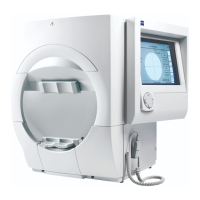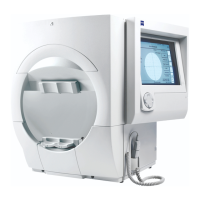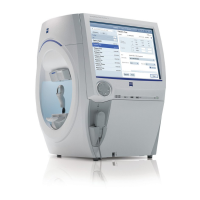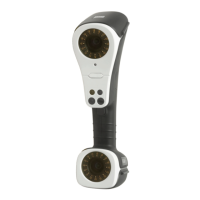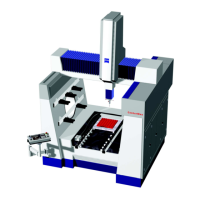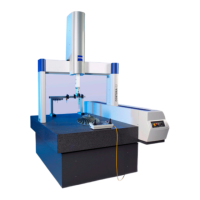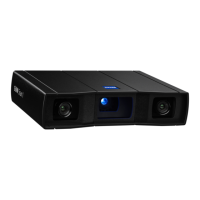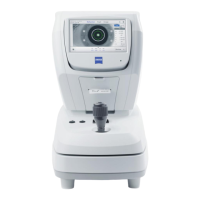Do you have a question about the Zeiss HUMPHREY 750i and is the answer not in the manual?
Details essential safety warnings and precautions for the instrument's installation and operation.
Describes the primary screen for initiating tests, recalling data, and accessing system setup.
Guides users through configuring system settings, including language, time, date, and printer options.
Provides detailed steps for calibrating the touch screen for accurate response.
Explains how to save custom configurations, including Main Menu buttons and test patterns.
Guides on restoring saved configurations from backup media.
Explains the process of rebuilding the hard disk database in case of failures.
Guides on choosing the appropriate test pattern and selecting the eye (right or left) for testing.
Details the process of inputting patient demographic and diagnostic information before a test.
Provides guidelines and methods for selecting and using trial lenses with the HFA II.
Covers essential steps for patient preparation, including instructions, seating, and lighting.
Explains how to adjust various testing parameters like stimulus size, speed, and fixation target.
Describes the SITA (Swedish Interactive Thresholding Algorithm) testing strategies for faster and more efficient perimetry.
Covers using the Video Eye Monitor and Gaze Tracking for ensuring proper patient fixation.
Describes options available while a test is running, such as pausing, changing parameters, or canceling.
Details options available upon test completion, including saving, displaying status, and printing.
Provides a sequential guide for performing a visual field test from start to finish.
Discusses key factors influencing test reliability, focusing on patient compliance and clear instructions.
Explains the importance of patient fixation and methods to improve it for reliable results.
Covers the correct usage of trial lenses and potential issues that can affect test reliability.
Defines fixation losses and how they are indicated on printouts, along with potential causes.
Explains false positive errors and their impact on test reliability, including 'trigger happy' patients.
Discusses false negative errors, their causes, and how they are presented in test results.
Explains the fluctuation value option and its role in assessing patient response consistency.
Introduces STATPAC software for expert analysis of visual field test results and its key features.
Discusses global indices like MD, PSD, SF, and CPSD used for overall assessment of visual fields.
Explains the Change Analysis printout, including box plots and linear regression for tracking changes over time.
Details the Glaucoma Change Probability Analysis (GCP) for interpreting changes in glaucoma patients.
Guides on printing current threshold test results in various STATPAC formats.
Details how to print current screening test results, including options for single or both eyes.
Explains how to obtain printouts of previously saved test results from disk.
Provides step-by-step instructions for common file operations like viewing tests and changing patient data.
Emphasizes the importance of database management and data safeguarding through backups.
Details recommended procedures for protecting patient databases using backups and media rotation.
Explains how to back up and restore instrument configurations, including test patterns and setup settings.
Guides on recognizing and resolving database failures, including hard drive issues.
Provides instructions for cleaning the exterior, bowl surface, touch screen, and other parts of the HFA II.
Provides detailed steps for calibrating the touch screen to ensure accurate input response.
Addresses common problems encountered when the HFA II fails to power on or display the main menu.
Guides on handling messages indicating hard disk failure and resolving patient name issues.
Addresses issues with floppy disks not being recognized, having errors, or being the wrong format.
Covers problems with magneto-optical disks not being recognized or being improperly formatted.
| Model | 750i |
|---|---|
| Manufacturer | Zeiss |
| Category | Measuring Instruments |
| Technology | Automated Static Perimetry |
| Stimulus Duration | 200 ms |
| Power Requirements | 100-240 VAC, 50/60 Hz |
| Test Types | Screening |
| Test Patterns | 30-2, 24-2, 10-2, Macula, Nasal Step |
| Background Illumination | 31.5 apostilbs (asb) |
| Stimulus Size | Goldmann Size III |
| Stimulus Color | White, Red, Green |
| Testing Strategy | SITA |
| Fixation Monitoring | Video Monitoring |
| Specialty Tests | Glaucoma Hemifield Test (GHT) |
| Connectivity | USB, Ethernet |
| Power Supply | Internal |
| Type | Visual Field Perimeter |
